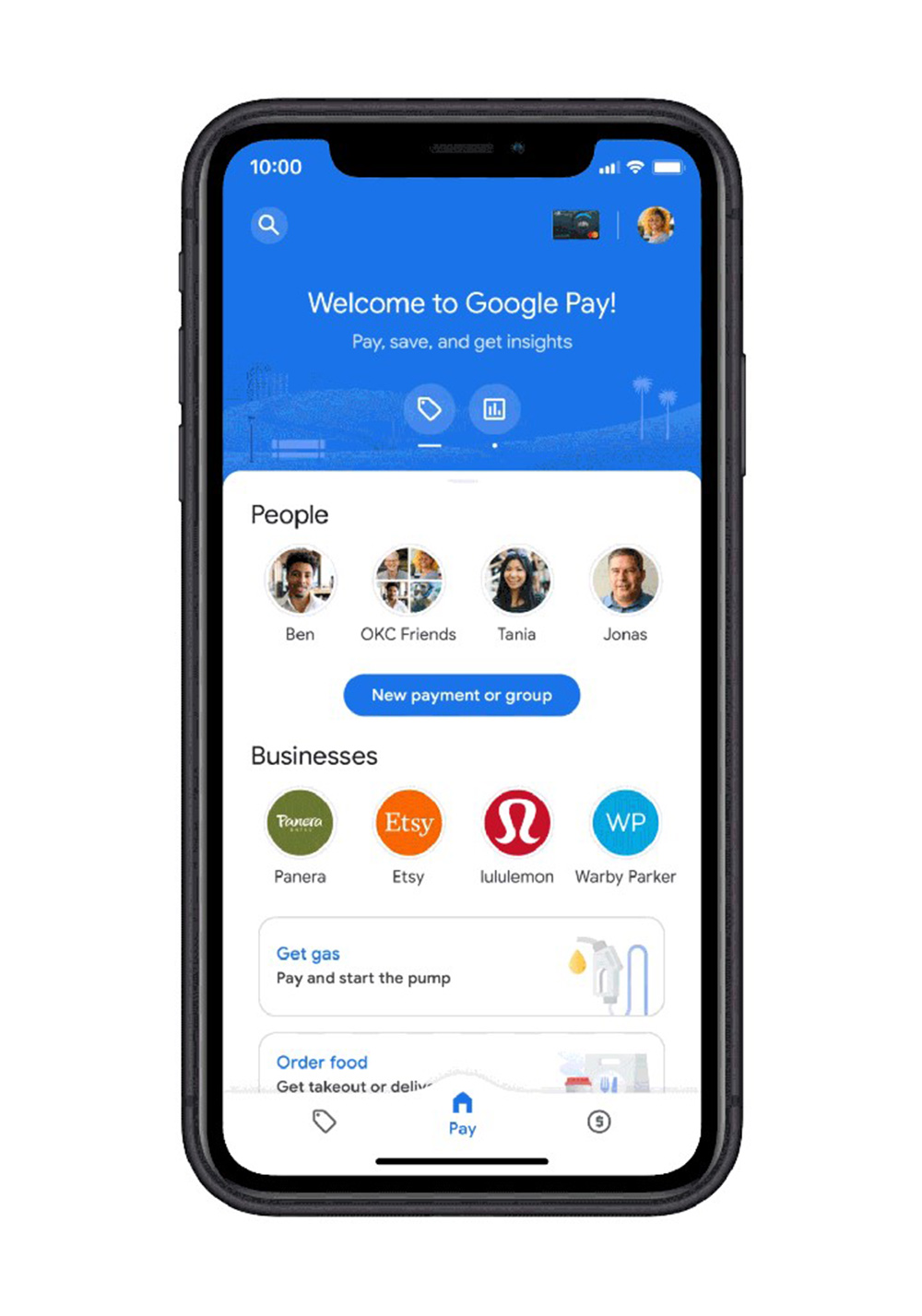谷歌(Google)在11月18日下午发布了改版后的美国版Google Pay,将打造一站式个人理财平台和手机支付应用程序。
这款新应用程序围绕“关系”进行重新设计,将人们交往最频繁的好友和企业作为设计的核心。改版后的新功能包括支持多人分摊费用的群组支付;汇总支出情况的财务“洞察”,帮助用户管理资金;综合了奖励积分、会员卡和交易的商户页面。
另外,谷歌还公布了最新手机银行产品Plex的11家银行合作伙伴,并在11月18日发布了Plex的候选合作伙伴名单。除了已知的合作伙伴花旗集团(Citi)和斯坦福联邦信用社(Stanford Federal Credit Union)以外,Bank Mobile、西班牙对外银行(BBVA)和BMO Harris等银行也将与谷歌合作,从明年开始为用户提供费用更低的数字支票和储蓄账户。
谷歌的支付业务负责人凯撒·森古普塔说:“我们对产品进行重新设计恰逢其时,但2020年也让这件事情变得非常紧迫。一方面,数字支付显然在飞速增长。另外一个原因是,面对人类历史上最严重的经济和财政危机,我们认为我们的技术可以在一些小的方面给人们带来帮助。”

谷歌的其他银行合作伙伴包括海岸社区银行(Coastal Community Bank)、第一独立银行(First Independence Bank)、绿点公司(Green Dot)、西雅图银行(Seattle Bank)、SEFCU和马里兰州港口银行(Harbor Bank of Maryland)等。
谷歌最初于2018年1月发布Google Pay,主要是为了方便信用卡、会员卡、交通卡等各种卡片支付。这款应用程序综合了谷歌之前的两款金融科技应用程序:点对点支付服务谷歌钱包(Google Wallet,约2011年)和实现了手机“无接触”支付的Android Pay(约2015年)。
森古普塔表示:“我们在五年前设计这款应用程序,主要围绕的使用案例是用卡片支付的问题。从我们发布Android Pay以来,世界已经发生了翻天覆地的变化。移动支付变得更普遍。”
最新版Google Pay增加了知名品牌的返现奖励和折扣,包括汉堡王(Burger King)、REI Co-op和塔吉特(Target)等。另外,这款应用程序还支持在超过10万家餐厅订餐,可在包括奥斯丁、波士顿和华盛顿特区在内的400多个城市支付停车费,还可以在3万多个加油站加油,包括壳牌(Shell)、埃克森美孚(Exxon Mobil)、Phillips 66、76和康菲石油(Conoco)等。
谷歌在一篇博客中开玩笑说:“更多方便的支付方式即将到来。”
Google Pay美国产品管理总监约什·伍德沃德向《财富》杂志演示了部分新功能。他演示了更智能的搜索功能,通过搜索“上周的墨西哥美食”可以显示在一家墨西哥餐厅最近进行的交易。他还从Gmail和谷歌照片(Google Photos)账号中找出了包含“衬衫”字样的收据图片。

谷歌表示将对用户的财务信息保密。森古普塔解释说:“我们绝不会把用户信息出售给第三方,也不会将信息分享给谷歌的其他部门用于定向营销。这是我们的坚定承诺。”(当然,需要注意的是,如果您与零售商和商户交易,加入他们的忠诚计划并领取奖励,您已经默认同意将您的个人数据提供给他们。)
这款应用程序的限制极其严格,因此如果没有获得用户的明确许可,Google Pay不会使用用户的交易记录为用户提供个性化的体验。人们可以试运行个性化功能三个月,再决定是否同意这种功能。
目前,Google Pay支持30多个国家,每月用户超过1.5亿。重新设计的应用程序现在已经能够在安卓(Android)和苹果(Apple)手机上下载。森古普塔补充说,未来公司将在新加坡、印度等其他地区陆续推出这些功能。(财富中文网)
译者:刘进龙
审校:汪皓
谷歌(Google)在11月18日下午发布了改版后的美国版Google Pay,将打造一站式个人理财平台和手机支付应用程序。
这款新应用程序围绕“关系”进行重新设计,将人们交往最频繁的好友和企业作为设计的核心。改版后的新功能包括支持多人分摊费用的群组支付;汇总支出情况的财务“洞察”,帮助用户管理资金;综合了奖励积分、会员卡和交易的商户页面。
另外,谷歌还公布了最新手机银行产品Plex的11家银行合作伙伴,并在11月18日发布了Plex的候选合作伙伴名单。除了已知的合作伙伴花旗集团(Citi)和斯坦福联邦信用社(Stanford Federal Credit Union)以外,Bank Mobile、西班牙对外银行(BBVA)和BMO Harris等银行也将与谷歌合作,从明年开始为用户提供费用更低的数字支票和储蓄账户。
谷歌的支付业务负责人凯撒·森古普塔说:“我们对产品进行重新设计恰逢其时,但2020年也让这件事情变得非常紧迫。一方面,数字支付显然在飞速增长。另外一个原因是,面对人类历史上最严重的经济和财政危机,我们认为我们的技术可以在一些小的方面给人们带来帮助。”
谷歌的其他银行合作伙伴包括海岸社区银行(Coastal Community Bank)、第一独立银行(First Independence Bank)、绿点公司(Green Dot)、西雅图银行(Seattle Bank)、SEFCU和马里兰州港口银行(Harbor Bank of Maryland)等。
谷歌最初于2018年1月发布Google Pay,主要是为了方便信用卡、会员卡、交通卡等各种卡片支付。这款应用程序综合了谷歌之前的两款金融科技应用程序:点对点支付服务谷歌钱包(Google Wallet,约2011年)和实现了手机“无接触”支付的Android Pay(约2015年)。
森古普塔表示:“我们在五年前设计这款应用程序,主要围绕的使用案例是用卡片支付的问题。从我们发布Android Pay以来,世界已经发生了翻天覆地的变化。移动支付变得更普遍。”
最新版Google Pay增加了知名品牌的返现奖励和折扣,包括汉堡王(Burger King)、REI Co-op和塔吉特(Target)等。另外,这款应用程序还支持在超过10万家餐厅订餐,可在包括奥斯丁、波士顿和华盛顿特区在内的400多个城市支付停车费,还可以在3万多个加油站加油,包括壳牌(Shell)、埃克森美孚(Exxon Mobil)、Phillips 66、76和康菲石油(Conoco)等。
谷歌在一篇博客中开玩笑说:“更多方便的支付方式即将到来。”
Google Pay美国产品管理总监约什·伍德沃德向《财富》杂志演示了部分新功能。他演示了更智能的搜索功能,通过搜索“上周的墨西哥美食”可以显示在一家墨西哥餐厅最近进行的交易。他还从Gmail和谷歌照片(Google Photos)账号中找出了包含“衬衫”字样的收据图片。
谷歌表示将对用户的财务信息保密。森古普塔解释说:“我们绝不会把用户信息出售给第三方,也不会将信息分享给谷歌的其他部门用于定向营销。这是我们的坚定承诺。”(当然,需要注意的是,如果您与零售商和商户交易,加入他们的忠诚计划并领取奖励,您已经默认同意将您的个人数据提供给他们。)
这款应用程序的限制极其严格,因此如果没有获得用户的明确许可,Google Pay不会使用用户的交易记录为用户提供个性化的体验。人们可以试运行个性化功能三个月,再决定是否同意这种功能。
目前,Google Pay支持30多个国家,每月用户超过1.5亿。重新设计的应用程序现在已经能够在安卓(Android)和苹果(Apple)手机上下载。森古普塔补充说,未来公司将在新加坡、印度等其他地区陆续推出这些功能。(财富中文网)
译者:刘进龙
审校:汪皓
Google released an overhauled U.S. version of its Google Pay app as a one-stop shop for personal finances and phone-based payments on November 18 afternoon.
The new app is redesigned around “relationships,” meaning it puts the friends and businesses people transact with most frequently front and center. New features include group payments, or the ability to split expenses among a number of individuals; financial “insights” that show spending summaries to help people manage their money; and merchant-specific pages that collate rewards offers, loyalty cards, and transactions into a unified view.
Google also revealed 11 bank partners for a new mobile banking product called Plex, a waitlist for which it made available on November 18. Banks including Bank Mobile, BBVA, and BMO Harris will join already known collaborators Citi and Stanford Federal Credit Union to offer people fee-less, digital checking and savings accounts starting next year.
“It was time for us to redesign the product, but 2020 also put a certain sense of urgency on it,” says Caesar Sengupta, Google’s head of payments. “Partly because digital payments have obviously increased dramatically. But also because, as you're looking at one of the worst economic and financial crises we've seen in our living history, this is a time when we feel our technology can be of use to people in some small way.”
Google’s other banking partners are Coastal Community Bank, First Independence Bank, Green Dot, Seattle Bank, SEFCU, and the Harbor Bank of Maryland.
When Google debuted Google Pay in January 2018, it primarily made paying with all variety of cards—credit, loyalty, transit—easier. The app joined together Google’s two earlier financial tech, or fintech, apps: Google Wallet (circa 2011), a peer-to-peer payment service, and Android Pay (circa 2015), which made “contact-less” payments possible from people’s phones.
“The current app, which we designed five years back, was very much built around the use case of a problem then, which was paying with cards,” Sengupta says. “The world has changed a lot since we launched Android Pay. It's much more mobile.”
The new Google Pay adds cash-back rewards and discounts from popular brands, such as Burger King, REI Co-op, and Target. The app adds integrations to order food at more than 100,000 restaurants, pay for parking in more than 400 cities, including Austin, Boston, and Washington, D.C., and purchase gas at more than 30,000 stations, including at Shell, Exxon Mobil, Phillips 66, 76, and Conoco.
“More easy ways to pay are coming soon,” Google teased in a blog post.
Josh Woodward, director of product management for Google Pay U.S., demoed some new features for Fortune. He showed off a smarter search function that surfaced recent transactions from a taco joint by searching “Mexican food from last week.” He also pulled up images of receipts containing the word “shirt,” collected from his Gmail and Google Photos accounts.
Google says it will keep people’s financial information private. “We're never going to sell your data to third parties, and we're not going to share it with the rest of Google for targeting,” Sengupta explains. “It’s a very clear, plain-speech commitment.” (Of course, note that if you transact with retailers and merchants, join their loyalty programs, and take up rewards, then you’re tacitly agreeing to give them your data.)
The app is so locked down that Google Pay won’t use people’s transaction history to personalize their app experience unless people explicitly grant it permission. People can test run the personalization feature for three months before deciding whether to green-light it.
Today, Google Pay is available in more than 30 countries, and it has more than 150 million monthly users. The redesigned app is now available on both Android and Apple phones. Sengupta adds the features will be rolled out to other regions, including Singapore and India, in the future.






